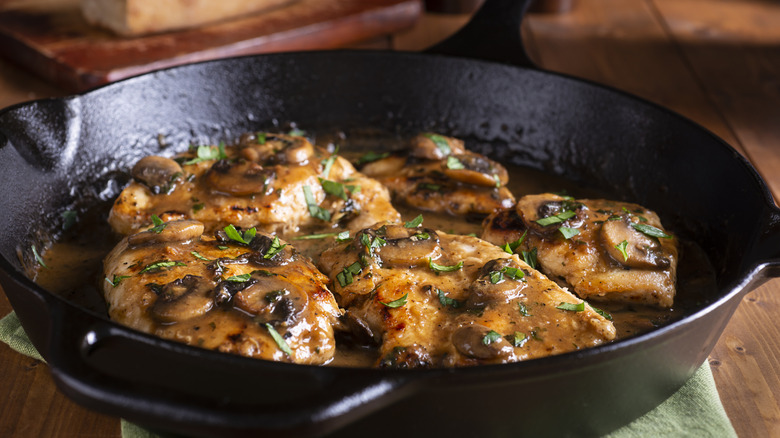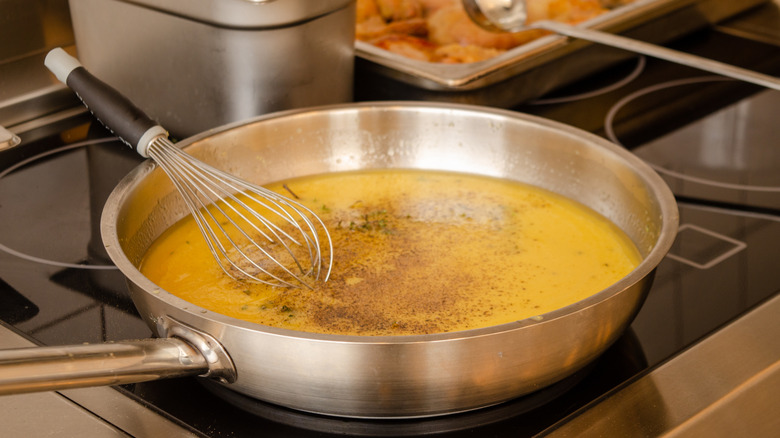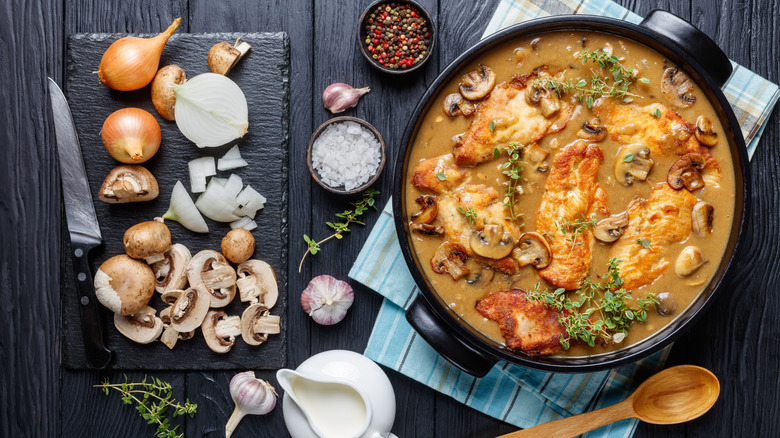The Trick That Will Save Your Broken Pan Sauce
A pan sauce, like an emulsified salad dressing or a perfectly cooked cut of steak, seems much more complicated to prepare than it actually is. In just a few steps you can create a glossy, rich sauce to accompany your meat dish that tastes as if it were professionally prepped. In fact, pan sauces are one of the few culinary preparations that you can ruin (and save) over and over again. To explain how this works, we have to start with the sauce itself.
A pan sauce begins with the remaining meat and fat left behind in your pan. Any cooked bits are then picked up when you deglaze the pan. After reducing your sauce, you'll add a good amount of your favorite homemade stock or even just water. After that liquid reduces a bit, you'll add fat (like butter or cream) back into the sauce and whisk quickly over heat to emulsify it. Your goal is to distribute droplets of the fat throughout the liquid for a creamy, cohesive sauce. The more fat you add, the richer your sauce will be.
If your pan sauce looks greasy or oily, rather than rich or creamy, it's broken. Your instinct might be to start over or look for a thickening agent, like flour or cornstarch, but counterintuitively you can fix your sauce with one simple step: just add water.
Why a pan sauce breaks so easily and how to fix it
The perfect pan sauce is all about ratios. A broken sauce has lost too much water to evaporation — you might notice that it reduced substantially very quickly. Since the fat has less area to distribute itself within evenly, it will start to pool, which not only looks bad, but tastes bad, too. A contributing factor to a broken sauce could be that your pan was too hot or that you didn't add enough water or stock in the first place. Another culprit is the fat itself. If it's warm or room temperature, its water content will also evaporate more quickly.
If too much water has evaporated, resulting in a broken pan sauce, just add some water or stock to re-suspend your fat droplets. Start with a ¼ cup and bring the heat up so your sauce is at a simmer. Keep agitating it to spread out the fat and re-emulsify your sauce. Keep cooking, or adding more liquid as needed, until it looks glossy and delicious.
We should note that your pan sauce can technically go beyond the point of no return. If you've burnt the milk solids from your butter or cream in a too-hot pan, it's time to reach for your favorite steak sauce from the fridge.
Tips for making the perfect pan sauce
There are a few secrets to making a stellar pan sauce, especially when it comes to the ingredients you use. The process starts by cooking a piece of meat — any meat will do: chicken, pork, beef, lamb, the list goes on. But you absolutely must sear your meat in a skillet with some stick to it, like a cast iron. Once you remove your meat from the pan to rest, you should have some browned, cooked bits (called fond) stuck to your pan. After draining off some of the fat, add in a few aromatics like garlic, shallot, ginger, cumin, or paprika, and let them bloom in what's left.
Next comes the fun part, where you'll deglaze the fond in your pan with your alcohol of choice. White wine works well with chicken, red wine with beef or lamb, or give sherry or vermouth a try. Cook the alcohol down substantially before adding any other liquid so your pan sauce picks up its sugars, not its sharp flavor, then whisk in your stock of choice or even water.
Finally, there's the intimidating part: emulsification. You'll want to whisk in cold butter or heavy cream straight out of the fridge. When your sauce looks richly opaque and creamy, you're ready to add finishing touches for flavor, such as parsley, capers, black pepper, a squeeze of lemon juice, or a dab of Dijon or spicy brown mustard. And remember, if your pan sauce breaks, the solution is simple.


